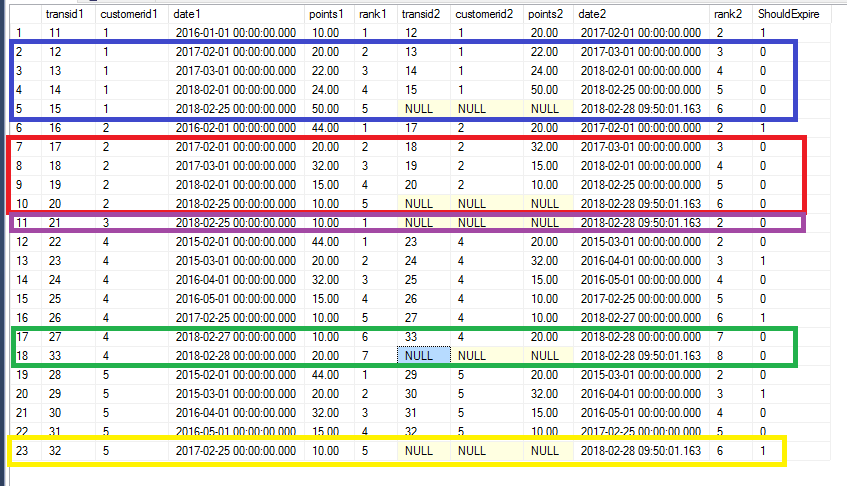Sql按最新重复字段分组
Sql按最新重复字段分组
提问于 2018-02-28 10:00:24
我甚至不知道这个问题的好标题是什么。
但我有张桌子
create table trans
(
[transid] INT IDENTITY (1, 1) NOT NULL,
[customerid] int not null,
[points] decimal(10,2) not null,
[date] datetime not null
)和记录:
--cus1
INSERT INTO trans ( customerid , points , date )
VALUES ( 1, 10, '2016-01-01' ) , ( 1, 20, '2017-02-01' ) , ( 1, 22, '2017-03-01' ) ,
( 1, 24, '2018-02-01' ) , ( 1, 50, '2018-02-25' ) , ( 2, 44, '2016-02-01' ) ,
( 2, 20, '2017-02-01' ) , ( 2, 32, '2017-03-01' ) , ( 2, 15, '2018-02-01' ) ,
( 2, 10, '2018-02-25' ) , ( 3, 10, '2018-02-25' ) , ( 4, 44, '2015-02-01' ) ,
( 4, 20, '2015-03-01' ) , ( 4, 32, '2016-04-01' ) , ( 4, 15, '2016-05-01' ) ,
( 4, 10, '2017-02-25' ) , ( 4, 10, '2018-02-27' ) ,( 4, 20, '2018-02-28' ) ,
( 5, 44, '2015-02-01' ) , ( 5, 20, '2015-03-01' ) , ( 5, 32, '2016-04-01' ) ,
( 5, 15, '2016-05-01' ) ,( 5, 10, '2017-02-25' );
-- selecting the data
select * from trans生产:
transid customerid points date
----------- ----------- --------------------------------------- -----------------------
1 1 10.00 2016-01-01 00:00:00.000
2 1 20.00 2017-02-01 00:00:00.000
3 1 22.00 2017-03-01 00:00:00.000
4 1 24.00 2018-02-01 00:00:00.000
5 1 50.00 2018-02-25 00:00:00.000
6 2 44.00 2016-02-01 00:00:00.000
7 2 20.00 2017-02-01 00:00:00.000
8 2 32.00 2017-03-01 00:00:00.000
9 2 15.00 2018-02-01 00:00:00.000
10 2 10.00 2018-02-25 00:00:00.000
11 3 10.00 2018-02-25 00:00:00.000
12 4 44.00 2015-02-01 00:00:00.000
13 4 20.00 2015-03-01 00:00:00.000
14 4 32.00 2016-04-01 00:00:00.000
15 4 15.00 2016-05-01 00:00:00.000
16 4 10.00 2017-02-25 00:00:00.000
17 4 10.00 2018-02-27 00:00:00.000
18 4 20.00 2018-02-28 00:00:00.000
19 5 44.00 2015-02-01 00:00:00.000
20 5 20.00 2015-03-01 00:00:00.000
21 5 32.00 2016-04-01 00:00:00.000
22 5 15.00 2016-05-01 00:00:00.000
23 5 10.00 2017-02-25 00:00:00.000我正试着把所有的顾客分类,并总结他们的观点。但这是一个陷阱,如果反式在1年内不活跃(下一次转换是1年及以上),那么积分将过期。
对于这种情况,每个客户的积分应该是:
Customer1 20+22+24+50
Customer2 20+32+15+10
Customer3 10
Customer4 10+20
Customer5 0到目前为止,我的情况如下:
select
t1.transid as transid1,
t1.customerid as customerid1,
t1.date as date1,
t1.points as points1,
t1.rank1 as rank1,
t2.transid as transid2,
t2.customerid as customerid2,
t2.points as points2,
isnull(t2.date,getUTCDate()) as date2,
isnull(t2.rank2,t1.rank1+1) as rank2,
cast(case when(t1.date > dateadd(year,-1,isnull(t2.date,getUTCDate()))) Then 0 ELSE 1 END as bit) as ShouldExpire
from
(
select transid,CustomerID,Date,points,
RANK() OVER(PARTITION BY CustomerID ORDER BY date ASC) AS RANK1
from trans
)t1
left join
(
select transid,CustomerID,Date,points,
RANK() OVER(PARTITION BY CustomerID ORDER BY date ASC) AS RANK2
from trans
)t2 on t1.RANK1=t2.RANK2-1
and t1.customerid=t2.customerid这给

从上表中,如何检查ShouldExpire字段的最大值(Rank1)是否为客户,如果为1,则总分为0,否则,所有连续的0之和,直到没有更多的记录或满足1?
还是有更好的方法来解决这个问题?
回答 4
Stack Overflow用户
回答已采纳
发布于 2018-02-28 13:19:34
下面的查询使用LEAD获取下一条记录的日期--使用相同的CustomerID片:
;WITH CTE AS (
SELECT transid, CustomerID, [Date], points,
LEAD([Date]) OVER (PARTITION BY CustomerID
ORDER BY date ASC) AS nextDate,
CASE
WHEN [date] > DATEADD(YEAR,
-1,
-- same LEAD() here as above
ISNULL(LEAD([Date]) OVER (PARTITION BY CustomerID
ORDER BY date ASC),
getUTCDate()))
THEN 0
ELSE 1
END AS ShouldExpire
FROM trans
)
SELECT transid, CustomerID, [Date], points, nextDate, ShouldExpire
FROM CTE
ORDER BY CustomerID, [Date]输出:
transid CustomerID Date points nextDate ShouldExpire
-------------------------------------------------------------
1 1 2016-01-01 10.00 2017-02-01 1 <-- last exp. for 1
2 1 2017-02-01 20.00 2017-03-01 0
3 1 2017-03-01 22.00 2018-02-01 0
4 1 2018-02-01 24.00 2018-02-25 0
5 1 2018-02-25 50.00 NULL 0
6 2 2016-02-01 44.00 2017-02-01 1 <-- last exp. for 2
7 2 2017-02-01 20.00 2017-03-01 0
8 2 2017-03-01 32.00 2018-02-01 0
9 2 2018-02-01 15.00 2018-02-25 0
10 2 2018-02-25 10.00 NULL 0
11 3 2018-02-25 10.00 NULL 0 <-- no exp. for 3
12 4 2015-02-01 44.00 2015-03-01 0
13 4 2015-03-01 20.00 2016-04-01 1
14 4 2016-04-01 32.00 2016-05-01 0
15 4 2016-05-01 15.00 2017-02-25 0
16 4 2017-02-25 10.00 2018-02-27 1 <-- last exp. for 4
17 4 2018-02-27 10.00 2018-02-28 0
18 4 2018-02-28 20.00 NULL 0
19 5 2015-02-01 44.00 2015-03-01 0
20 5 2015-03-01 20.00 2016-04-01 1
21 5 2016-04-01 32.00 2016-05-01 0
22 5 2016-05-01 15.00 2017-02-25 0
23 5 2017-02-25 10.00 NULL 1 <-- last exp. for 5现在,您似乎想要计算上一次过期后的点数之和。
使用上述CTE作为基础,您可以通过以下方法获得所需的结果:
;WITH CTE AS (
... above query here ...
)
SELECT CustomerID,
SUM(CASE WHEN rnk = 0 THEN points ELSE 0 END) AS sumOfPoints
FROM (
SELECT transid, CustomerID, [Date], points, nextDate, ShouldExpire,
SUM(ShouldExpire) OVER (PARTITION BY CustomerID ORDER BY [Date] DESC) AS rnk
FROM CTE
) AS t
GROUP BY CustomerID输出:
CustomerID sumOfPoints
-----------------------
1 116.00
2 77.00
3 10.00
4 30.00
5 0.00Demo here
Stack Overflow用户
发布于 2018-02-28 10:27:57
这里棘手的部分是在所有点过期时转储,然后重新开始累积它们。我以为,如果只有一笔交易,直到有一笔新的交易,我们才能到期,即使第一笔交易是一年前的事了?
对于客户#5,我也得到了一个不同的答案,因为他们似乎有一个尚未过期的“交易链”?
以下是我的查询:
WITH ordered AS (
SELECT
*,
ROW_NUMBER() OVER (PARTITION BY customerid ORDER BY [date]) AS order_id
FROM
trans),
max_transid AS (
SELECT
customerid,
MAX(transid) AS max_transid
FROM
trans
GROUP BY
customerid),
not_expired AS (
SELECT
t1.customerid,
t1.points,
t1.[date] AS t1_date,
CASE
WHEN m.customerid IS NOT NULL THEN GETDATE()
ELSE t2.[date]
END AS t2_date
FROM
ordered t1
LEFT JOIN ordered t2 ON t2.customerid = t1.customerid AND t1.transid != t2.transid AND t2.order_id = t1.order_id + 1 AND t1.[date] > DATEADD(YEAR, -1, t2.[date])
LEFT JOIN max_transid m ON m.customerid = t1.customerid AND m.max_transid = t1.transid
),
max_not_expired AS (
SELECT
customerid,
MAX(t1_date) AS max_expired
FROM
not_expired
WHERE
t2_date IS NULL
GROUP BY
customerid)
SELECT
n.customerid,
SUM(n.points) AS points
FROM
not_expired n
LEFT JOIN max_not_expired m ON m.customerid = n.customerid
WHERE
ISNULL(m.max_expired, '19000101') < n.t1_date
GROUP BY
n.customerid;可以将其重构为更简单,但我想说明得出最终答案的步骤:
customerid points
1 116.00
2 77.00
3 10.00
4 30.00
5 57.00Stack Overflow用户
发布于 2018-02-28 10:12:33
你能试试这个吗?
SELECT customerid,
Sum(t1.points)
FROM trans t1
WHERE NOT EXISTS (SELECT 1
FROM trans t2
WHERE Datediff(year, t1.date, t2.date) >= 1)
GROUP BY t1.customerid 希望能帮上忙!
页面原文内容由Stack Overflow提供。腾讯云小微IT领域专用引擎提供翻译支持
原文链接:
https://stackoverflow.com/questions/49026695
复制相关文章
相似问题

